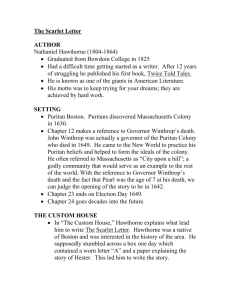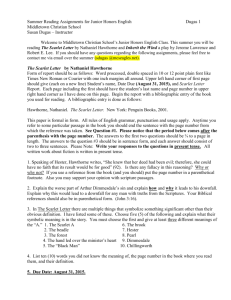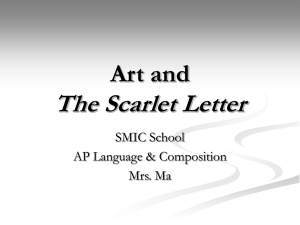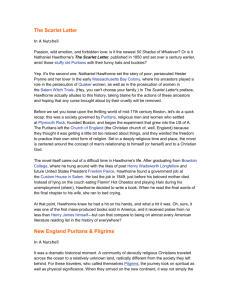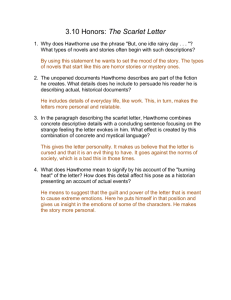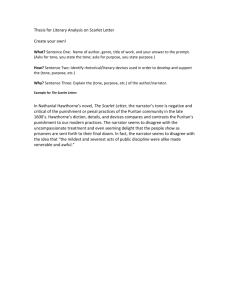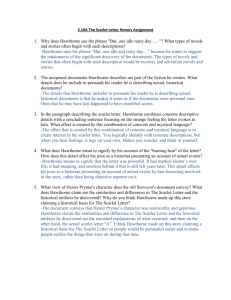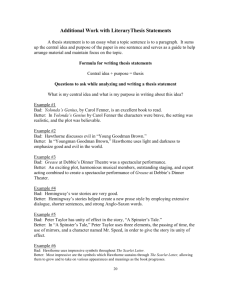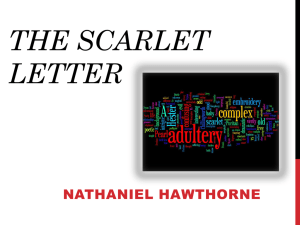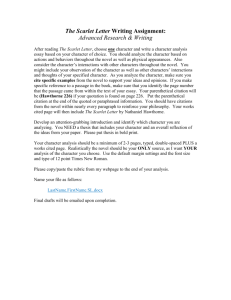1 Puritanism in America - Beavercreek City School District
advertisement
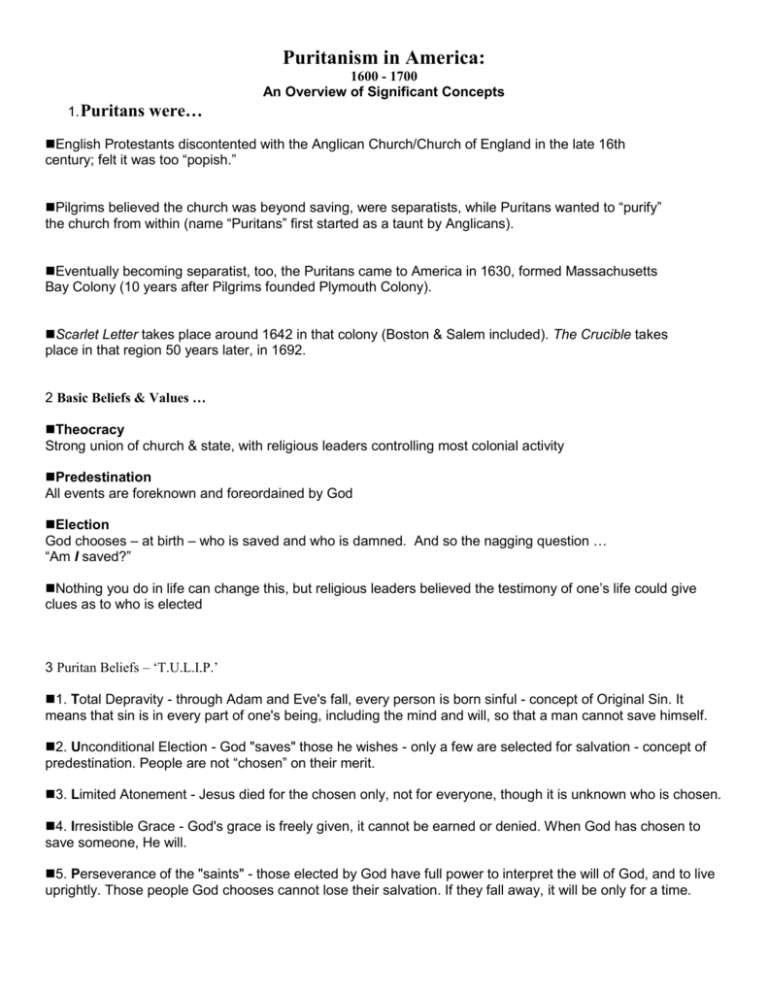
Puritanism in America: 1600 - 1700 An Overview of Significant Concepts 1. Puritans were… English Protestants discontented with the Anglican Church/Church of England in the late 16th century; felt it was too “popish.” Pilgrims believed the church was beyond saving, were separatists, while Puritans wanted to “purify” the church from within (name “Puritans” first started as a taunt by Anglicans). Eventually becoming separatist, too, the Puritans came to America in 1630, formed Massachusetts Bay Colony (10 years after Pilgrims founded Plymouth Colony). Scarlet Letter takes place around 1642 in that colony (Boston & Salem included). The Crucible takes place in that region 50 years later, in 1692. 2 Basic Beliefs & Values … Theocracy Strong union of church & state, with religious leaders controlling most colonial activity Predestination All events are foreknown and foreordained by God Election God chooses – at birth – who is saved and who is damned. And so the nagging question … “Am I saved?” Nothing you do in life can change this, but religious leaders believed the testimony of one’s life could give clues as to who is elected 3 Puritan Beliefs – ‘T.U.L.I.P.’ 1. Total Depravity - through Adam and Eve's fall, every person is born sinful - concept of Original Sin. It means that sin is in every part of one's being, including the mind and will, so that a man cannot save himself. 2. Unconditional Election - God "saves" those he wishes - only a few are selected for salvation - concept of predestination. People are not “chosen” on their merit. 3. Limited Atonement - Jesus died for the chosen only, not for everyone, though it is unknown who is chosen. 4. Irresistible Grace - God's grace is freely given, it cannot be earned or denied. When God has chosen to save someone, He will. 5. Perseverance of the "saints" - those elected by God have full power to interpret the will of God, and to live uprightly. Those people God chooses cannot lose their salvation. If they fall away, it will be only for a time. 4 Basic Beliefs & Values … The Bible Provided the indispensable guide to life, and the church should therefore reflect the express teaching of the scriptures. The Bible tells people exactly how to behave. All humans are sinful & depraved “Original sin” … from the time of birth People have free will, but will naturally choose evil if left unchecked. Forgiveness through Jesus Christ alone But He died for only the elected & predestined 5. Basic Beliefs & Values … Abundant grace/Personal salvation Given only by God Cannot be earned Intolerance Society is one unified whole, so sin & error of any kind must be opposed & driven out Anne Hutchinson (1638) Criticized ministers for not preaching grace, that faith alone could get you into heaven Held religious meetings in her home Challenged political & religious leadership of Massachusetts Bay colony Persecuted & banished 6 Basic Beliefs & Values … Intolerance Roger Williams (1638) Preached complete separation of church & state Opposed taxes to support religious groups Supported paying Indians for land Persecuted & expelled for “new & dangerous opinions” Settled Rhode Island Established complete freedom of religion (including Jews, Catholics, Quakers) 7 Basic Beliefs & Values … Patriarchy Male-dominated society; only men can vote/hold office; women are in service to their husbands. Superstitious Strong belief in the devil, witches, etc., and their ability to inhabit the bodies of people. 8 Basic Beliefs & Values … Puritan Childhood Little concept of childhood/play Children should be seen and not heard--little adults Sunday church services lasting 9 or 10 hours Children put to work around age 7 Girls go to live/work in others’ homes by age 14 or so Most families have around 7 children; only 1 in 3 made it to age 10 Life expectancy in the 17th century (1600s) was about 32 10 Education Education highly prized as a form of self-improvement, and to be able to read the Bible. Formed the first public school in New England, the Roxbury Latin School, in 1635 Mandatory public school for all children Founded the first college, Harvard, in 1636 to train ministers First to print children’s books, The New England Primer (1688); had an alphabet and catechism (religious training). Was used for nearly 100 years throughout the region As a result, about 70% of New England was literate in 1770 11 The New England Primer Alphabet book with religious instruction geared toward obedience: Letter A – “In Adam’s fall, we sinned all” Letter I – “The Idle fool is whipt at school” 12 The New England Primer 13 Puritan Legacy, Positive & Negative The need for moral justification for private, public, & governmental acts The quest for freedom - personal, political, economic, and social; democracy in church led to democracy in government The Puritan work ethic Shaming as a form of social control 14 Puritan Legacy, Positive & Negative The city upon a hill – concept of manifest destiny, moral excellence & conscience Community values – that we are all responsible for the well-being of each other The value of education for individual & community success The Scarlet Letter Upon finishing The Scarlet Letter in 1850, Nathaniel Hawthorne read the manuscript to his wife, Sophia. “It broke her heart,” Hawthorne wrote, “and “sent her to bed with a grievous headache, which I look upon as a triumphant success.” Hawthorne originally intended The Scarlet Letter to be a short story but expanded it at the suggestion of his publisher. The Scarlet Letter was such a popular and critical success that American writer Henry James later wrote that its publication was “a literary event of the first importance. The book was the finest piece of imaginative writing yet put forth in the country.” The Scarlet Letter displays Hawthorne’s lifelong preoccupation with the thematic ideas of secrecy and guilt, sin and redemption, the conflict between intellectual and moral pride, and the lingering effects of Puritanism. This lifelong preoccupation with guilt and shame likely came from Hawthorne having had distant ancestors involved in the Salem Witch Trials of 1692. • Hawthorne called The Scarlet Letter “a romance,” but he defined romance as a work of fiction that can “claim a certain latitude with the ordinary course of man’s experience,” as long as it shows “the truth of the human heart.” • Rather than focusing on outer realism, Hawthorne’s work focused on the inner truths of human experience. The Scarlet Letter is peopled with characters who are meant to be the embodiments of moral traits, rather than realistic, living figures. • The novel begins with a long preface, “The Custom House,” unnecessary to the story, but which gives a fictional back story about Hawthorne discovering an old, tattered “Scarlet Letter.” • He writes that there was some “deep meaning” in the “mystic symbol.” 25 29 The Prison-Door Hawthorne opens The Scarlet Letter just outside the prison of what, in the early 1640s, was the village of Boston. 26 Ask yourself what you know about a novel that begins in a prison? You probably suspect you are reading the story of a crime already committed, of characters whose lives are already darkened by guilt and disgrace…. And, in the case of The Scarlet Letter… ... you are quite right. Look carefully at the details of the opening scene: “The sad-colored garments” of the spectators; the prison-door itself, “Heavily timbered with and studded with iron spikes.” These details create a somber mood; they paint a cheerless picture. And they hint, as well, at a society that places punishment far above forgiveness on its scale of values. One note of color relieves the gloom. A wild rose bush blossoms by the prison door. The rose bush suggests a world beyond the narrow confines of the Puritan community. A world where beauty and vibrant color flourish and crime finds tolerance and pity. 33 The Scarlet Letter The year is 1642. The place is Boston, a small Puritan settlement. Before the town jail, a group of somber people wait with stern expressions. They are expecting Hester Prynne, a woman convicted of adultery. You will not know it yet. But even this early, Hawthorne has marked the thematic boundaries of his novel: law and nature repression and freedom “The Market Place” gives -- in one vivid image -- the whole story. The lines of conflict are drawn, the issues defined, the characters placed in relation to one another. The image Hawthorne gives us is that of a young woman guilty of adultery, and standing on a scaffold in the midst of a hostile crowd. This is Puritan Boston, where private wrongdoing is public knowledge.
